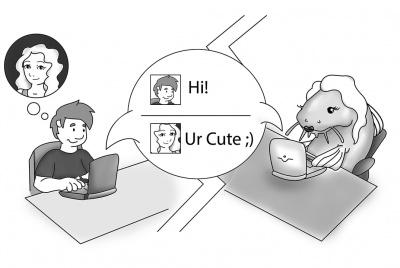Online Dating - Catfishing Edition
Catfishing refers to an action performed by someone who utilizes another person’s online identity to seek out friends or love interests. A few reasons someone may be more inclined to use a false online identity include but are not limited to: low self esteem, depression or anxiety, seek revenge, explore their sexuality, and to seek out revenge or harassment.[1] The idea of catfishing has long been a part of society but it did not get it’s name until 2010 when Nev Schulman released a film about his journey meeting a woman he was chatting with online and then discovering that she was not the person she identified herself as. From then on, many people seemed to identify with the film because they had similar stories which caused Nev to create a TV Show to share those stories.
Catfishing affects people in certain communities more than others whether that be in relation to race, gender, or sexual orientation. Catfishing is also done by certain communities more than others. As stated previously, people utilize online profiles to impersonate and at times, deceive others.[2]

Contents
Demographics
According to a source that gathers data from the FBI database, the demographics of those who perform these acts seem to come from Alaska as of 2021.[4] Right behind Alaska, it is stated that Nevada and Wisconsin are also very prominent in catfishing cases. On the contrary, states with few cases include: Vermont, South Dakota, and Montana. Once people report these cases of being catfished where scams are involved, states calculate the amount lost and add those numbers up over the course of the year. Wisconsin being in the midwest is among the most dangerous scamming states.[5]
A company did their own research on their community members to see who has catfished before. Their data suggested that 1 in 5 people out of 16,827 have impersonated someone else online to favor others. [6] They also found that 25% of men pretended to be someone else versus 18% of the women who participated in the poll. They also found data in relation to race and ethnicity. About 28% of people who identify as Asian use a different social media identity than themselves. Following this is 23% for people who identify as Hispanic and 20% for people who identify as African American.[7]

Catfish: The TV Show
The 8 season show stemmed from the movie created by Nev Schulman about his experience with a woman whose online identity was not her true identity. Schulman also can get credited for creating the word which he came up with after a conversation with the woman and her husband. Schulman then started the show to share more stories of people who related to his situation of being catfished. Schulman and Max Joseph then co-hosted 7 seasons of Catfish with one another, traveling across the nation to find out if someone’s lover was really them or an impersonation of someone else. The show is currently on its 8th season with Schulman and now Kamie Crawford. [9]
In one particular episode, Shulman and Joseph went with a person that requested to be on the show to find the person he was communicating with for several months and who he thought was the love of his life. They approached the house and the person that appeared was a man who had been impersonating a woman online. The discussion they had when they finally met was filled with anger and disappointment.
Catfishing on Dating/Networking Platforms
With the continuing rise of online dating and social networking platforms such as Tinder, Hinge, Bumble, and Grindr, among others, catfishers are in a position to catfish more than ever before. The nature of these online platforms allows for virtually anybody to make an account and assume an identity that is not their own in order to make them more appealing for other users to interact with. Often, there are not sufficient safeguards put into place during the account creation process for these applications to ensure that someone is not engaging in catfishing and/or using someone else’s photos or other personal information. The account creation process is often as simple as entering an email address, a name, age, phone number, and from that point, the user is given the benefit of the doubt. [10]
An attempt at a safeguard against catfishing and spam on these social platforms includes Tinder’s Photo Verification feature, which was introduced in the beginning of 2020. The feature is opt-in, and the mechanism for it is that Tinder will prompt users to take a series of selfies in which the user will assume certain poses. Afterwards, the selfies will be sent in for both a manual and automated review. Accounts passing this review will then be given a blue check mark on their profile [11]. Bumble has a similar offering on its platform [12] [13] While there is no source that directly indicates just how much this feature has reduced catfishing, the feature allows for reasonable affirmation that someone on Tinder is who they claim to be.
Ethical Concerns
The many options of social media applications to engage in gives people a plethora of opportunities to interact with other people however they choose. This wide variety of social media applications allows for the possibility of one to interact with someone whose online presence is not their true self and in certain capacities when a professional is impersonated, it is illegal.[14]
Catfishing is an activity that often exploits other people’s anxieties, self-confidence (or lack thereof), as well as optimism in looking for a partner or friend [15]. Notably, in early-mid 2020 as travel and gathering restrictions were enacted due to the ongoing COVID-19 pandemic, attention was once again brought to catfishing [16]. Due to the largely remote nature of most interactions during the pandemic due to social distancing, potential catfishers were less deterred by the prospect of eventually having to meet with someone they were communicating with [16]. That, in addition to the added stressors of life due to quarantine/isolation anxieties as well as fears of catching the virus, people could generally be in a state that is more susceptible to being a target of catfishing [16]. According to a poll by the American Psychiatric Association released in October 2020, 62% of Americans reported feeling anxious, a roughly 30% uptick from the same poll at the same time last year [17]. These conditions foster ripe prey for catfishers.
See Also
References
- ↑ Brennan MD,D.(2020, December 03)."Signs of Catfishing". WebMD.https://www.webmd.com/sex-relationships/signs-catfishing
- ↑ (2017, January 10)."Abuse Using Technology". Women's Law.https://www.womenslaw.org/about-abuse/forms-abuse/technology-abuse/technology-tool-abuse/impersonation
- ↑ Craddock,B.(2013, February 08)."Something's Fishy: Safety concerns come hand-in-hand with online dating".The Flare Online.https://theflareonline.com/2013/02/somethings-fishy-safety-concerns-come-hand-in-hand-with-online-dating/
- ↑ Grant,A."States with the Highest Catfishing Rates". https://bestvpn.org/catfishing-statistics/
- ↑ Nyman,S.(2019, June 06)."Suckers for love? Report shows Wisconsin among top states for romance scams".Post Crescent.https://www.postcrescent.com/story/life/2019/06/06/catfishing-statistics-wisconsin-ranks-no-3-romance-scams/1365159001/
- ↑ Miles,K.(2019, May 15)."Men Are More Likely Than Women To Catfish".Branded.https://gobranded.com/men-likely-women-catfish
- ↑ Miles,K.(2019, May 15)."Men Are More Likely Than Women To Catfish".Branded.https://gobranded.com/men-likely-women-catfish
- ↑ Buckman,C.(2018, January 22)."'Catfish: The TV Show' makes casting stop at SDSU".The Daily Aztec.https://thedailyaztec.com/87229/artsandculture/catfish-the-tv-show-makes-casting-stop-at-sdsu/#
- ↑ "(2012)."Catfish: The TV Show".MTV. https://www.mtv.com/shows/catfish-the-tv-show/3wergr/season-6
- ↑ Tinder: A Guide To Tinder: Signing Up and Getting Started: How do I create a Tinder account? https://www.help.tinder.com/hc/en-us/articles/115003356706-How-do-I-create-a-Tinder-account-
- ↑ Tinder: What is Photo Verification? https://www.help.tinder.com/hc/en-us/articles/360034941812-What-is-Photo-Verification-
- ↑ Carman, A. (2020, Jan 23) The Verge: Tinder will give you a verified blue check mark if you pass its catfishing test. https://www.theverge.com/2020/1/23/21077423/tinder-photo-verification-blue-checkmark-safety-center-launch-noonlight
- ↑ Bumble Photo Verification - KISS CATFISH GOODBYE https://bumble.com/the-buzz/the-end-of-catfishing-introducing-photo-verification
- ↑ (2012, August 17)."Online impersonation laws".Reputation Defender.https://www.reputationdefender.com/blog/privacy/online-impersonation-laws
- ↑ The Cybersmile Foundation - Catfishing https://www.cybersmile.org/what-we-do/advice-help/catfishing
- ↑ 16.0 16.1 16.2 Lopez, C. (2020, Apr 26) Insider - Coronavirus lockdowns create fertile ground for catfishers on dating apps, and the stress of it all may make the victims more willing to believe them https://www.insider.com/catfishing-on-the-rise-because-of-covid-19-quarantines-2020-4
- ↑ American Psychiatric Association (Oct 21, 2020) New APA Poll Shows Surge in Anxiety Among Americans Top Causes Are Safety, COVID-19, Health, Gun Violence, and the Upcoming Election https://www.psychiatry.org/newsroom/news-releases/anxiety-poll-2020